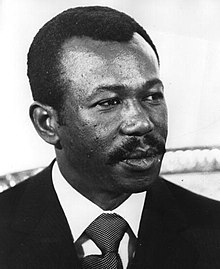Mengistu Haile-Mariam
| Mengistu Haile Mariam | |
|---|---|
 |
|
| Chairman of the Derg and Head of State of Ethiopia | |
|
In office 3 February 1977 – 10 September 1987 |
|
| Preceded by | Tafari Benti |
| Succeeded by | Himself as President |
| President of Ethiopia | |
|
In office 10 September 1987 – 21 May 1991 |
|
| Prime Minister |
Fikre Selassie Wogderess Hailu Yimenu Tesfaye Dinka |
| Vice President | Tesfaye Gebre Kidan |
| Preceded by | Himself as Chairman of the Derg |
| Succeeded by | Tesfaye Gebre Kidan |
| General Secretary of the Workers' Party of Ethiopia | |
|
In office 12 September 1984 – 21 May 1991 |
|
| Preceded by | Position established |
| Succeeded by | Position abolished |
| Personal details | |
| Born |
21 May 1937 Wolayita, Ethiopia |
| Political party | Workers Party of Ethiopia |
| Spouse(s) | Wubanchi Bishaw |
| Children | Temehert Tigest Andenet |
Mengistu Haile Mariam (Amharic: መንግስቱ ኃይለ ማርያም?, pronounced [mənɡɨstu haɪlə marjam]; born 21 May 1937) is an Ethiopian politician who was the leader of Ethiopia from 1977 to 1991. He was the chairman of the Derg, the Communist military junta that governed Ethiopia, from 1977 to 1987, and the President of the People's Democratic Republic of Ethiopia from 1987 to 1991. The Derg took power in the Ethiopian Revolution following the overthrow of Emperor Haile Selassie I in 1974, marking the end of the Solomonic dynasty which had ruled Ethiopia since the 13th century. Mengistu purged rivals for power from the Derg and made himself Ethiopia's dictator, attempting to modernise Ethiopia's feudal economy through Marxist-inspired policies such as nationalisation and land redistribution. His bloody consolidation of power in 1977-1978 is known as the Ethiopian Red Terror, a brutal crackdown on opposition groups and civilians following a failed assassination attempt by the Ethiopian People's Revolutionary Party in September 1976, after they had ignored the Derg's invitation to join the union of socialist parties.
Internal rebellion and government repression characterised Mengistu's presidency, the Red Terror period being a battle for dominance between the Derg, the EPRP and their rivals the All-Ethiopia Socialist Movement, who had initially aligned themselves with the Derg. While this internal conflict was being fought Ethiopia was threatened by both Somalian invasion and the guerilla campaign of the Eritrean People's Liberation Front who demanded independence for Eritrea, then a province of Ethiopia. The Ogaden War of 1977-1978 over a disputed border region with Somalia was notable for the prominent role of Mengistu's Soviet and Cuban allies in securing an Ethiopian victory. The catastrophic famine of 1983-1985 is what brought his regime the most international attention.
...
Wikipedia
